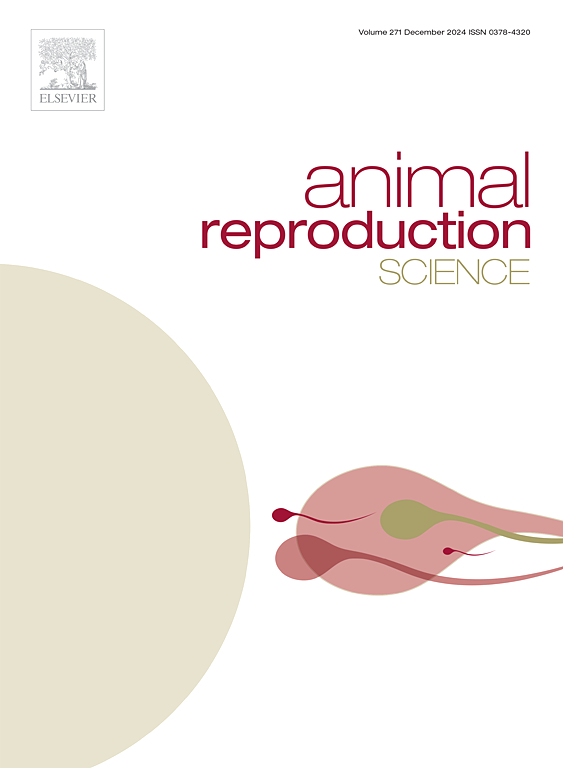Investigation of the utility of PCR-RFLP as a rapid alternative to DNA sequencing for interrogation of the genetic sex of Mugil cephalus
IF 3.3
2区 农林科学
Q1 AGRICULTURE, DAIRY & ANIMAL SCIENCE
引用次数: 0
Abstract
Mugil cephalus is a species of considerable interest for aquaculture. As a species that is not sexually dimorphic, when building a brood stock with a balanced sex ratio there is difficulty for identification of sex until the animals are quite mature. When mono-sex populations of this species is desired, as in the case of production of females for “bottarga”, considerable resource expenditure could be saved if early sorting of sexes were possible to enable selection of a single sex. A recently described sex-associated loci within the follicle stimulating hormone receptor gene (fshr) was identified using genomic DNA sequencing and shown to contain some non-synonymous mutations wherein the females have a tendency to be homozygous and the males heterozygous. The loci identification method is time-consuming and somewhat expensive. We propose that the method described for the identification of the genetic sex of Mugil cephalus, prior to sexual maturation should be rapid and not require DNA sequencing. In this work, we demonstrate the utilization of one of these fshr mutations within this genetic marker in a PCR-RFLP assay. Using this new method, the loci in question shows 77.8 % partitioning with males and 88.9 % partition with females, as referenced to phenotypic sex characterized by histology, thus confirming the partitioning of the genetic marker as seen previously using DNA sequencing. Future applications of this relatively rapid and inexpensive method could contribute to the production of mono-sex farmed stock and open new opportunities for more efficient broodstock management practices in the species.
研究用 PCR-RFLP 快速替代 DNA 测序来检测鲻鱼的遗传性别。
鲻鱼是水产养殖中颇受关注的鱼种。由于该鱼种没有性二型,因此在建立性别比例均衡的育苗群时,很难识别其性别,直到动物相当成熟。当需要该物种的单性别种群时,如生产 "bottarga "的雌鱼,如果能及早进行性别分类,以便选择单一性别,则可节省大量资源支出。最近在促卵泡激素受体基因(fshr)中发现了一个与性别相关的基因位点,通过基因组 DNA 测序确定了该基因位点,结果显示该基因位点含有一些非同义突变,其中雌性基因倾向于同源突变,而雄性基因倾向于异源突变。这种基因位点鉴定方法既费时又昂贵。我们建议,在性成熟前鉴定鲻鱼遗传性别的方法应快速且无需 DNA 测序。在这项工作中,我们展示了在 PCR-RFLP 分析中利用该遗传标记中的一个 fshr 突变。使用这种新方法,根据组织学的表型性别特征,该基因位点显示出 77.8% 的雄性和 88.9% 的雌性分区,从而证实了之前使用 DNA 测序所看到的遗传标记分区。这种相对快速且成本低廉的方法在未来的应用将有助于单性别养殖鱼种的生产,并为该物种更高效的育种管理实践带来新的机遇。
本文章由计算机程序翻译,如有差异,请以英文原文为准。
求助全文
约1分钟内获得全文
求助全文
来源期刊

Animal Reproduction Science
农林科学-奶制品与动物科学
CiteScore
4.50
自引率
9.10%
发文量
136
审稿时长
54 days
期刊介绍:
Animal Reproduction Science publishes results from studies relating to reproduction and fertility in animals. This includes both fundamental research and applied studies, including management practices that increase our understanding of the biology and manipulation of reproduction. Manuscripts should go into depth in the mechanisms involved in the research reported, rather than a give a mere description of findings. The focus is on animals that are useful to humans including food- and fibre-producing; companion/recreational; captive; and endangered species including zoo animals, but excluding laboratory animals unless the results of the study provide new information that impacts the basic understanding of the biology or manipulation of reproduction.
The journal''s scope includes the study of reproductive physiology and endocrinology, reproductive cycles, natural and artificial control of reproduction, preservation and use of gametes and embryos, pregnancy and parturition, infertility and sterility, diagnostic and therapeutic techniques.
The Editorial Board of Animal Reproduction Science has decided not to publish papers in which there is an exclusive examination of the in vitro development of oocytes and embryos; however, there will be consideration of papers that include in vitro studies where the source of the oocytes and/or development of the embryos beyond the blastocyst stage is part of the experimental design.
 求助内容:
求助内容: 应助结果提醒方式:
应助结果提醒方式:


